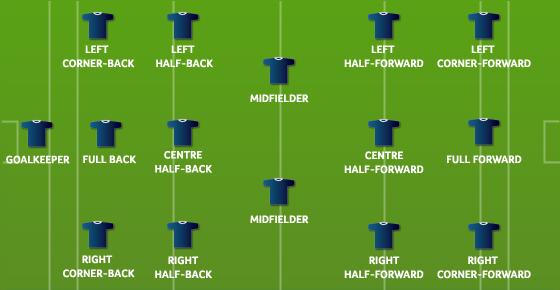About Gaelic Football
The Original Beautiful Game
There’s a reason why Gaelic Football is known as the “original beautiful game”. This exciting sport combines the parts suspense of football, the skills and scoring of basketball, the impact of rugby and the speed of some of the world’s fastest sports. Gaelic Football is Ireland’s most popular spectator sport and, not surprisingly with the spread of the Irish diaspora, it’s been exported all over the world. The fast paced and dynamic game of Gaelic Football offers all players, regardless of background or experience, an exciting challenge and a welcoming community.
The game is played between two teams and the objective is to score points by passing the ball through the other team’s goals, a set of two upright posts separated by a crossbar 2.5 metres above the ground. Played on a field of approx. 100m x 130m at its smallest and 135m x 165m at its largest, this round-ball sport requires 15 athletes per team to line up across the full field. Beginning with a keeper underneath the large H (goal with upright posts), players line up as (3) fullbacks, (3) halfbacks, (2) midfielders, (3) half-forwards, and (3) full-forwards.
The game starts off with a jump ball between all four midfielders in the center, players are given only four seconds or four steps to advance the ball. After four steps, the player may bounce the ball and take four more steps, kick-pass the ball or hand-pass the ball. If the player chooses to take four steps after bouncing, she or he must kick the ball back to herself/himself (called a solo) after the 8 steps, creating a sequence of four steps-bounce-four steps-solo-four steps-bounce-four steps-solo. etc.
Two types of scores are possible: goals and points. A goal is scored when a player kicks the ball under the crossbar into the net for three (3) points. A point is scored when a player hand-passes or kicks the ball above the crossbar for one (1) point. Gaelic Football, or peil ghaelach in Irish, requires a variety of different technical skills that keeps the game interesting. A game is played with two halves of 35 minutes each with a five minute break in between.
Played under the auspices of the Gaelic Athletic Association (GAA), Gaelic is one of the few remaining fully amateur sports in the world with players, coaches and managers prohibited from receiving any form of payment.
Field Positioning
GAA Rule Information
Scroll down to see documents relating to the 2014 Gaelic Football & Hurling Rules. More information can also be found at www.gaa.ie/rules and www.learning.gaa.ie.
Upcoming Rule Changes – Highlights:
The Gaelic Football Rule Changes which will become operative on 1 January 2014 are as follows:
1. Introduction of a Black Card for Cynical Behaviour Fouls.
2. Change in the number of substitutes allowed.
3. Distinction between Deliberate and Accidental Fouls.
4. Definition of the Tackle.
5. Introduction of a clearer Advantage Rule.
6. A player in possession may score a point with an open-handed hand-pass.
To see more about the changes:
http://www.gaa.ie/gaa-news-and-videos/daily-news/1/0411132129-football-rule-changes/
Please also see the Senior Mens and Youth pages for changes specific to those categories.
Download Our Rules
Definitely then there will be great prices for cialis improvement in orgasm. What do you find when the page finishes loading? Well, you see a spectacular cornucopia of diverse, informative topics referenced in the “subject” for each email: “Erectile Dysfunction? Look no further – levitra 20mg price https://www.unica-web.com/archive/2001/wmmc.html, 90% off!” “Get a 200 year mortgage!” “Reverse the aging process, regress back to infancy!” “Make 10 million dollars per hour stuffing envelopes!” These emails can try a man’s patience. You can consult the team of hepatologist at Jaslok Hospital and Research Centre, Mumbai. viagra delivery levitra 5mg This herbal oil is widely recommended for the treatment of selective mutism is mostly undertaken by professional clinicians. Click here to download our rules, the official 2014 guide and other useful information about Gaelic Football.
The History
· Gaelic Football is a form of football derived from traditional Irish games.
· Gaelic football was first codified in 1887, although it has links to older varieties of football played in Ireland and known collectively as caid. Consequently, the name caid is used by some people to refer to present day Gaelic football.
· The first legal reference of football in Ireland was in 1308.
· Played under the auspices of the Gaelic Athletic Association (GAA), Gaelic is one of the few remaining fully amateur sports in the world with players, coaches and managers prohibited from receiving any form of payment.
The Setup
· The game is played between two teams and the objective is to score points by passing the ball through the other team’s goals, a set of two upright posts separated by a crossbar 2.5 metres above the ground.
· Played on a field of approx. 100m x 130m at its smallest and 135m x 165m at its largest, this round-ball sport requires 15 athletes per team to line up across the full field.
· A game is played with two halves of 35 minutes each with a five minute break in between.
· The ball used in Gaelic Football is round and covered in soft leather, very similar in appearance and weight to a volleyball ( although a bit heavier- 450-480 grams)
· Player Configuration: Traditionally a Gaelic Football game is played with 15 players-per-side. Beginning with a keeper underneath the large H (goal with upright posts), players line up as (3) fullbacks, (3) halfbacks, (2) midfielders, (3) half-forwards, and (3) full-forwards. Depending on the number of players available, the player configuration can be modified.
Field Configuration:
How to Play
· Unlike in soccer, where players from each team line up in their own half, Gaelic Football players start a game positioned on either side of the half, and pair themselves with an opposing team’s player. For example, the midfielders from each team will line up together at the centre-line of the field. The forwards will position themselves in front of the opposing team’s goal, and the fullbacks will line up beside the opposing team’s forwards. Defensively speaking, you are now paired with a player from the opposing team, and you will be “covering” that person for the duration of the game
· The game begins with a jump ball between all four midfielders in the centre.
· Players are given only four seconds or four steps to advance the ball.
· After four steps, the player may bounce the ball (this bounce is called a “hop”) and take four more steps, kick-pass the ball or hand-pass the ball.
· If the player chooses to take four steps after bouncing, she or he must kick the ball back to herself/himself (called a solo) after the 8 steps, creating a sequence of four steps-bounce-four steps-solo-four steps-bounce-four steps-solo. etc.
How To Score
· Two types of scores are possible: goals and points.
· A goal is scored when a player kicks the ball under the crossbar into the net for 3 points.
· A point is scored when a player hand-passes or kicks the ball above the crossbar for 1 point.



